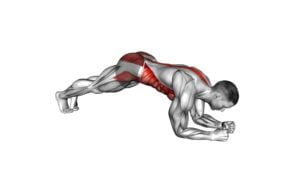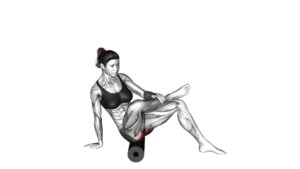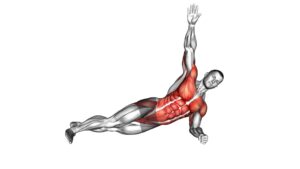Hip Roll Plank (female) – Video Exercise Guide & Tips

Get ready to strengthen your core and tone those abs with the Hip Roll Plank!
Watch This Exercise Video
In this video exercise guide, we'll show you how to perform this challenging move with proper form and technique.
Whether you're a beginner looking for modifications or an advanced fitness enthusiast seeking a challenge, we've got you covered.
Avoid common mistakes, maximize your results, and get ready to feel the burn!
Let's dive in and get those hips rolling!
Key Takeaways
- The Hip Roll Plank is a beneficial exercise that improves stability, increases core strength, targets abdominal muscles, lower back, and hips, and provides an effective full-body workout.
- Proper form and technique are essential for performing the Hip Roll Plank correctly, including maintaining a stable position, engaging core muscles throughout the movement, avoiding hip sagging or lifting too high, squeezing abdominal muscles, and breathing steadily.
- Beginners can modify the exercise by starting on their knees instead of toes, performing with hands elevated on a step or bench, gradually increasing the difficulty level, focusing on engaging core muscles, and maintaining a straight line from head to heels.
- Advanced variations of the Hip Roll Plank include the one-arm hip roll plank, weighted hip roll plank, elevated hip roll plank, and knee tuck hip roll plank. Incorporating weights can also add resistance to the exercise.
Benefits of the Hip Roll Plank
You can experience several benefits from incorporating the hip roll plank into your workout routine. This exercise is a great way to improve stability and increase core strength. The hip roll plank targets your abdominal muscles, lower back, and hips, making it an effective full-body workout.
First and foremost, the hip roll plank helps to improve stability. By engaging your core muscles and maintaining a stable position, you're training your body to better control its movements. This can be particularly useful in activities that require balance and coordination, such as running, dancing, or playing sports.
Additionally, the hip roll plank is a fantastic exercise for increasing core strength. As you hold the plank position and roll your hips from side to side, you're engaging your abdominal muscles, obliques, and lower back. This not only helps to sculpt and tone your midsection but also improves overall core stability and support.
Incorporating the hip roll plank into your workout routine can have numerous benefits. By improving stability and increasing core strength, you can enhance your overall fitness level and performance in various physical activities. So, why not give it a try and see the positive impact it can have on your body?
Proper Form and Technique
To ensure proper form and technique for the hip roll plank exercise, it's essential to maintain a stable position and engage your core muscles throughout the movement. One common error is allowing your hips to sag or lift too high, which can put strain on your lower back and decrease the effectiveness of the exercise. To improve, focus on keeping your body in a straight line from your head to your heels.
Another common mistake isn't fully engaging your core muscles. To correct this, squeeze your abdominal muscles and imagine pulling your belly button towards your spine. This will help stabilize your body and activate the muscles needed for the hip roll plank. Additionally, make sure to breathe steadily and avoid holding your breath during the exercise. Proper breathing will help you maintain control and stability.
By implementing these tips for improvement, you can ensure that you're performing the hip roll plank exercise with the correct form and technique.
Transitioning into the next section about modifications for beginners, let's explore how to adapt this exercise for those who are just starting their fitness journey.
Modifications for Beginners
To make the hip roll plank exercise more accessible for beginners, it's important to gradually increase the difficulty level of the movement. Start by performing the exercise on your knees instead of your toes. This modification will help you build core strength while reducing the strain on your wrists and shoulders. As you become more comfortable with the movement, you can progress to performing the hip roll plank on your toes.
Another modification for beginners is to perform the exercise with your hands elevated on a step or bench. This will decrease the amount of body weight you have to support, making it easier to maintain proper form. As your core strength improves, you can gradually lower the height of the elevation until you're able to perform the exercise on the floor.
Remember to engage your core muscles throughout the exercise and maintain a straight line from your head to your heels. By starting with these modifications, you'll be able to build a solid foundation of core strength and gradually progress to more advanced variations for a challenge.
Advanced Variations for a Challenge
To further challenge yourself in the hip roll plank exercise, here are four advanced variations that you can incorporate:
- One-arm hip roll plank: Instead of having both hands on the ground, perform the exercise with one hand on the ground and the other hand extended towards the ceiling. This variation increases the demand on your core muscles and challenges your stability.
- Weighted hip roll plank: Add some extra resistance by placing a weight plate or dumbbell on your hips. This won't only intensify the workout for your core, but it will also engage your hip muscles even more.
- Elevated hip roll plank: Place your feet on an elevated surface, such as a step or a bench, while performing the hip roll plank. This increases the range of motion and adds more challenge to your core and hip muscles.
- Knee tuck hip roll plank: From the starting position of the hip roll plank, pull your knees towards your chest and then extend them back out. This dynamic movement targets your abs and hip flexors, making it an excellent advanced variation.
Incorporating these advanced modifications and incorporating weights will push your hip roll plank exercise to new heights, helping you build strength, stability, and definition in your core and hip muscles.
Common Mistakes to Avoid
When performing the hip roll plank, it's important to avoid two common mistakes: incorrect hip alignment and lack of core engagement.
Keep your hips in line with your shoulders and heels to ensure proper alignment and maximize the effectiveness of the exercise.
Additionally, engage your core muscles by actively pulling your belly button towards your spine throughout the movement.
Incorrect Hip Alignment
If you want to avoid making common mistakes with hip alignment, focus on maintaining proper form during the hip roll plank exercise. Incorrect hip alignment can lead to various issues, such as lower back pain, hip tightness, and decreased core engagement.
To ensure correct hip alignment, keep the following tips in mind:
- Avoid sagging hips: Keep your hips lifted and in line with your body throughout the exercise.
- Engage your core: Activate your abdominal muscles to stabilize your body and maintain proper alignment.
- Don't let your hips rotate: Prevent your hips from rotating or twisting by engaging your glutes and maintaining a neutral position.
- Maintain a straight line: Your body should form a straight line from your head to your heels, ensuring proper alignment and maximum effectiveness.
Lack of Core Engagement
Maintaining proper form during the hip roll plank exercise is crucial to avoid a lack of core engagement and its associated negative effects. Core strengthening is a fundamental aspect of overall fitness and stability. When you fail to engage your core muscles properly, you miss out on the full benefits of the exercise.
Without adequate core engagement, you may experience decreased stability and increased strain on other muscle groups. This can lead to improper alignment and potential injuries. It's important to prioritize core stability during the hip roll plank by actively contracting your abdominal muscles and maintaining a neutral spine.
Tips for Maximizing Results
To maximize your results with the hip roll plank exercise, focus on engaging your core muscles throughout the movement. Here are some tips to help you maximize your results:
- Maintain proper form: Keep your body in a straight line from head to toe, and avoid sagging or lifting your hips too high. This will ensure that your core muscles are fully engaged.
- Breathe correctly: Exhale as you roll your hips to the side, and inhale as you return to the starting position. This helps to activate your deep core muscles and maintain stability.
- Increase the challenge: Once you have mastered the basic hip roll plank, you can make it more challenging by adding a leg lift or a knee tuck. This will further engage your core and increase the intensity of the exercise.
- Incorporate variations: Don't be afraid to try different variations of the hip roll plank, such as side plank hip rolls or forearm plank hip rolls. These variations target different muscles and can help to prevent boredom and plateau.
Frequently Asked Questions
How Many Sets and Repetitions Should I Do for the Hip Roll Plank Exercise?
For the hip roll plank exercise, you should aim to do 2 to 3 sets of 10 to 12 repetitions. This will help you build strength and stability in your core and hips.
However, keep in mind that everyone's fitness level is different, so start with a number that feels challenging but manageable for you.
As you progress, you can increase the number of sets and repetitions or try alternative variations to keep challenging your muscles and get the maximum benefits.
Can I Do the Hip Roll Plank Exercise if I Have Lower Back Pain?
If you have lower back pain, it's important to listen to your body and avoid exercises that aggravate it. The hip roll plank may put strain on your lower back, so it mightn't be the best choice for you. However, there are alternative exercises that can target your core without causing discomfort.
It's always a good idea to consult with a healthcare professional to find the best exercises for your specific condition. The benefits of the hip roll plank include strengthening your core and improving stability.
Is It Necessary to Engage My Core During the Hip Roll Plank Exercise?
To get the most out of the hip roll plank exercise, it's important for you to engage your core. By doing so, you'll strengthen your abdominal muscles and improve your overall stability. Engaging your core will also help protect your lower back during the exercise, reducing the risk of injury.
If you're a beginner, you can modify the hip roll plank by starting with your knees on the ground and gradually working your way up to a full plank position.
Can I Do the Hip Roll Plank Exercise on a Yoga Mat or Do I Need a Specific Type of Surface?
Yes, you can do the hip roll plank exercise on a yoga mat or any exercise surface. The important thing is to have a stable and comfortable surface to perform the exercise.
Using a yoga mat can provide extra cushioning and grip, which can be beneficial for your wrists and overall stability.
However, if you don't have a yoga mat, you can still do the exercise on any flat surface as long as it's stable and doesn't cause discomfort.
Are There Any Specific Breathing Techniques I Should Follow While Performing the Hip Roll Plank Exercise?
When doing the hip roll plank exercise, it's important to focus on your breathing technique. Take a deep breath in as you roll your hips to one side, and exhale as you roll to the other side. This will help engage your core muscles and maintain control throughout the movement.
Conclusion
In conclusion, the hip roll plank is a highly effective exercise that targets the core muscles and improves stability. By maintaining proper form and technique, beginners can gradually build strength and flexibility.
Advanced variations offer a challenge for those looking to take their workout to the next level. Avoiding common mistakes and following tips for maximizing results will ensure optimal benefits from this exercise.
Incorporate the hip roll plank into your fitness routine for a stronger and more stable core.

Author
Years ago, the spark of my life’s passion ignited in my mind the moment I stepped into the local gym for the first time. The inaugural bead of perspiration, the initial endeavor, the very first surge of endorphins, and a sense of pride that washed over me post-workout marked the beginning of my deep-seated interest in strength sports, fitness, and sports nutrition. This very curiosity blossomed rapidly into a profound fascination, propelling me to earn a Master’s degree in Physical Education from the Academy of Physical Education in Krakow, followed by a Sports Manager diploma from the Jagiellonian University. My journey of growth led me to gain more specialized qualifications, such as being a certified personal trainer with a focus on sports dietetics, a lifeguard, and an instructor for wellness and corrective gymnastics. Theoretical knowledge paired seamlessly with practical experience, reinforcing my belief that the transformation of individuals under my guidance was also a reflection of my personal growth. This belief holds true even today. Each day, I strive to push the boundaries and explore new realms. These realms gently elevate me to greater heights. The unique combination of passion for my field and the continuous quest for growth fuels my drive to break new ground.







